Combined Prediction Model of Gas Concentration Based on Indicators Dynamic Optimization and Bi-LSTMs
Abstract
1. Introduction
2. Research and Theoretical Background
2.1. Data Sources
2.2. Prediction Theories
2.2.1. Spearman’s Rank Correlation Coefficient
2.2.2. Long Short-Term Memory Network
2.2.3. Bi-Directional Long Short-Term Memory Network
3. Methodology
3.1. Prediction Methods
3.2. Prediction Model
3.2.1. Correlation Analysis
3.2.2. Indicators Dynamic Optimization
3.2.3. Features Extraction
- (1)
- Time series features
- (2)
- Spatial topology features
3.2.4. Gas Concentration Prediction Model
- (1)
- Bi-LSTM single indicator model
- (2)
- LSTM dynamic optimized indicators combined model
3.3. Model Evaluation
4. Results
4.1. Data Preprocessing
4.2. Model Training
4.3. Prediction Results
4.4. Model Comparison
5. Discussion
6. Conclusions
- (1)
- The Spearman’s rank correlation between gas concentration and other indicators is analyzed. The gas concentration, temperature, and humidity indicators have a strong correlation with the gas concentration to be predicted, and Spearman’s rank correlation coefficient can reach 0.92 at most. For a certain indicator, its correlation with gas concentration fluctuates with time, with a maximum range of 1.53. The prediction effect of a single indicator on gas concentration is not stable, it is necessary to consider that the correlation changes with time at the prediction moment to dynamically optimize indicators;
- (2)
- A dynamic optimization method for prediction indicators based on Spearman’s rank correlation coefficient is proposed. This method not only considers the spatiotemporal relationship of indicators, but also the change of correlation between other indicators and gas concentration with time, reducing the training cost and model complexity, and improving the model convergence speed and training efficiency;
- (3)
- A new combined prediction model of gas concentration based on indicators dynamic optimization and Bi-LSTMs is established, which can predict the gas concentration for the next 30 min. Using the proposed model, the average R2 of predicted value and real value is 0.965, and the average prediction efficiency R for gas abnormal or normal emission is 79.9%. The proposal of this new prediction model significantly reduces the missing alarm and eliminates false alarms. Compared with other models, the gas concentration prediction is more accurate, and the missing alarm of gas abnormal emission is greatly alleviated, which greatly improves the alarming accuracy;
- (4)
- The research of this paper is a “Point prediction” of gas concentration for three key gas sensors. “Two-dimension prediction” or “Three-dimension prediction” for gas concentration could realize to visualize the gas concentration prediction area in the mining face, and it is also the key direction of future research. In addition, the influence of adjustable parameters of the model on prediction performance will be also the focus of future research. The research in this paper lays the foundation for future research.
Author Contributions
Funding
Institutional Review Board Statement
Informed Consent Statement
Data Availability Statement
Acknowledgments
Conflicts of Interest
References
- Wang, E.; Zhang, G.; Zhang, C.; Li, Z. Research progress and prospect on theory and technology for coal and gas outburst control and prevention in China. J. China Coal Soc. 2022, 47, 297–322. [Google Scholar] [CrossRef]
- Yu, M.; Yang, X.; Zheng, K.; Luan, P. Progress and development of coal mine gas explosion suppression and disaster reduction technology in China. J. China Coal Soc. 2020, 45, 168–188. [Google Scholar] [CrossRef]
- Li, B.; Wang, E.; Shang, Z.; Li, Z.; Li, B.; Liu, X.; Wang, H.; Niu, Y.; Wu, Q.; Song, Y. Deep learning approach to coal and gas outburst recognition employing modified AE and EMR signal from empirical mode decomposition and time-frequency analysis. J. Nat. Gas Sci. Eng. 2021, 90, 103942. [Google Scholar] [CrossRef]
- Zhang, G.; Wang, E.; Ou, J.; Li, Z. Regional prediction of coal and gas outburst under uncertain conditions based on the spatial distribution of risk index. Nat. Resour. Res. 2022, 31, 3319–3339. [Google Scholar] [CrossRef]
- Chen, L.; Wang, E.; Feng, J.; Kong, X.; Li, X.; Zhang, Z. A dynamic gas emission prediction model at the heading face and its engineering application. J. Nat. Gas Sci. Eng. 2016, 30, 228–236. [Google Scholar] [CrossRef]
- Song, D.Z.; He, X.Q.; Qiu, L.M.; Zhao, Y.J.; Cheng, X.H.; Wang, A.H. Study on real time dynamic monitoring and early warning technology of regional and local outburst danger. Coal Sci. Technol. 2021, 49, 110–119. [Google Scholar] [CrossRef]
- Wang, G.F.; Ren, H.W.; Zhao, G.R.; Gong, S.X.; Du, Y.B.; Xue, Z.X.; Pang, Y.H.; Zhang, X. Digital model and giant system coupling technology system of smart coal mine. J. China Coal Soc. 2022, 47, 61–74. [Google Scholar] [CrossRef]
- Chen, H.Z.; Wang, Y. Design and realization of integrated emergency response system in safety monitoring system of coal mine based on GIS. Min. Res. Dev. 2019, 39, 121–125. [Google Scholar] [CrossRef]
- Ge, S.; Hao, S.; Zhang, S.; Zhang, X.F.; Zhang, L.; Wang, S.B.; Wang, Z.B.; Bao, J.S.; Yang, X.L.; Yang, J.J. Status of intelligent coal mining technology and potential key technologies in China. Coal Sci. Technol. 2020, 48, 28–46. [Google Scholar] [CrossRef]
- Lai, X.W.; Xia, Y.N.; Zheng, W.B.; Cui, J.F.; Wu, Y.Q.; Shi, Y.X. Improved grey prediction of gas concentration sequence based on integrated learning. J. Saf. Sci. Technol. 2021, 17, 16–21. [Google Scholar] [CrossRef]
- Dai, W.; Ji, C.P.; Wang, Y.J. The prediction of multi-scale entropy on gas concentration time series based on variational mode decomposition. J. Nanoelectron. Optoelectron. 2019, 14, 1313–1325. [Google Scholar] [CrossRef]
- Wang, P.; Wu, Y.P.; Wang, S.L.; Song, C.; Wu, X.M. Study on Lagrange-ARIMA real-time prediction model of mine gas concentration. Coal Sci. Technol. 2019, 47, 141–146. [Google Scholar] [CrossRef]
- Fu, H.; Liu, Y.Z.; Xu, N.; Zhang, J.N. Research on gas concentration prediction based on multi-sensor-deep long short-term memory network fusion. Chin. J. Sens. Actuators 2021, 34, 784–790. [Google Scholar] [CrossRef]
- Zhang, Z.; Zhu, Q.; Li, Q.; Liu, Y.; Zhang, E.H.; Zhao, Q.M.; Qing, X.F. Prediction of mine gas concentration in heading face based on Keras long short time memory network. Saf. Environ. Eng. 2021, 28, 61–67+78. [Google Scholar] [CrossRef]
- Zhang, T.; Song, S.; Li, S.; Ma, L.; Pan, S.; Han, L. Research on gas concentration prediction models based on LSTM multidimensional time series. Energies 2019, 12, 161. [Google Scholar] [CrossRef]
- Lyu, P.; Chen, N.; Mao, S.; Li, M. LSTM based encoder-decoder for short-term predictions of gas concentration using multi-sensor fusion. Process Saf. Environ. Prot. 2020, 137, 93–105. [Google Scholar] [CrossRef]
- Li, S.G.; Ma, L.; Pan, S.B.; Shi, X. Research on prediction model of gas concentration based on RNN in coal mining face. Coal Sci. Technol. 2020, 48, 33–38. [Google Scholar] [CrossRef]
- Song, S.; Li, S.; Zhang, T.; Ma, L.; Pan, S.; Gao, L. Research on a multi-parameter fusion prediction model of pressure relief gas concentration based on RNN. Energies 2021, 14, 1384. [Google Scholar] [CrossRef]
- Zhang, Y.; Guo, H.; Lu, Z.; Zhan, L.; Hung, P.C. Distributed gas concentration prediction with intelligent edge devices in coal mine. Eng. Appl. Artif. Intell. 2020, 92, 103643. [Google Scholar] [CrossRef]
- Wu, J.; Liu, G.; Wang, J.; Zuo, Y.; Bu, H.; Lin, H. Data Intelligence: Trends and Challenges. Syst. Eng.-Theory Pract. 2020, 40, 2116–2149. [Google Scholar] [CrossRef]
- Cheng, L.; Li, L.; Li, S.; Ran, S.; Zhang, Z.; Zhang, Y. Prediction of gas concentration evolution with evolutionary attention-based temporal graph convolutional network. Expert Syst. Appl. 2022, 200, 116944. [Google Scholar] [CrossRef]
- Wang, X.; Xu, N.; Meng, X.; Chang, H. Prediction of gas concentration based on LSTM-LightGBM variable weight combination model. Energies 2022, 15, 827. [Google Scholar] [CrossRef]
- Wu, H.; Shi, S.; Lu, Y.; Liu, Y.; Huang, W. Top corner gas concentration prediction using t-distributed Stochastic Neighbor Embedding and Support Vector Regression algorithms. Concurr. Comput.-Pract. Exp. 2020, 32, e5705. [Google Scholar] [CrossRef]
- Meng, X.R.; Chang, H.Q.; Wang, X.Q. Methane concentration prediction method based on deep learning and classical time series analysis. Energies 2022, 15, 2262. [Google Scholar] [CrossRef]
- Dey, P.; Saurabh, K.; Kumar, C.; Pandit, D.; Chaulya, S.K.; Ray, S.K.; Prasad, G.M.; Mandal, S.K. t-SNE and variational auto-encoder with a bi-LSTM neural network-based model for prediction of gas concentration in a sealed-off area of underground coal mines. Soft Comput. 2022, 25, 14183–14207. [Google Scholar] [CrossRef]
- Xu, N.; Wang, X.; Meng, X.; Chang, H. Gas concentration prediction based on IWOA-LSTM-CEEMDAN residual correction model. Sensors 2022, 22, 4412. [Google Scholar] [CrossRef] [PubMed]
- Janusz, A.; Sikora, M.; Wróbel, L.; Stawicki, S.; Grzegorowski, M.; Wojtas, P.; Ślęzak, D. Mining Data from Coal Mines: IJCRS’15 Data Challenge. Rough Sets Fuzzy Sets Data Min. Granul. Comput. 2015, 9437, 429–438. [Google Scholar] [CrossRef]
- Zagorecki, A. Prediction of methane outbreaks in coal mines from multivariate time series using random forest. Rough Sets Fuzzy Sets Data Min. Granul. Comput. 2015, 9437, 494–500. [Google Scholar] [CrossRef]
- Ślęzak, D.; Grzegorowski, M.; Janusz, A.; Kozielski, M.; Nguyen, S.H.; Sikora, M.; Stawicki, S.; Wróbel, Ł. A framework for learning and embedding multi-sensor forecasting models into a decision support system: A case study of methane concentration in coal mines. Inf. Sci. 2018, 451, 112–133. [Google Scholar] [CrossRef]
- Janusz, A.; Grzegorowski, M.; Michalak, M.; Wróbel, Ł.; Sikora, M.; Ślęzak, D. Predicting seismic events in coal mines based on underground sensor measurements. Eng. Appl. Artif. Intell. 2017, 64, 83–94. [Google Scholar] [CrossRef]
- Li, H.M.; Cao, Y.C.; Su, L.M. Pythagorean fuzzy multi-criteria decision-making approach based on Spearman rank correlation coefficient. Soft Comput. 2022, 26, 3001–3012. [Google Scholar] [CrossRef]
- Wang, D.L.; Su, A.X.; Liu, W.P. Trend analysis of vegetation cover changes based on Spearman Rank correlation coefficient. J. Appl. Sci. 2019, 37, 519–528. [Google Scholar] [CrossRef]
- Greff, K.; Srivastava, R.K.; Koutník, J.; Steunebrink, B.R.; Schmidhuber, J. LSTM: A Search Space Odyssey. IEEE Trans. Neural Netw. Learn. Syst. 2017, 28, 2222–2232. [Google Scholar] [CrossRef]
- Ma, Y.; Peng, H.; Khan, T.; Cambria, E.; Hussain, A. Sentic LSTM: A Hybrid Network for Targeted Aspect-Based Sentiment Analysis. Cogn. Comput. 2018, 10, 639–650. [Google Scholar] [CrossRef]
- Yin, J.; Deng, Z.; Ines, A.V.; Wu, J.; Rasu, E. Forecast of short-term daily reference evapotranspiration under limited meteorological variables using a hybrid bi-directional long short-term memory model (Bi-LSTM). Agric. Water Manag. 2020, 242, 106386. [Google Scholar] [CrossRef]
- Liang, T.; Zhao, Q.; Lv, Q.; Sun, H. A novel wind speed prediction strategy based on Bi-LSTM, MOOFADA and transfer learning for centralized control centers. Energy 2021, 230, 120904. [Google Scholar] [CrossRef]
- Zhou, Z.; Zhang, J.J.; Ding, H.H.; Li, F. Settlement prediction model of shield tunnel under-crossing existing tunnel based on GA-Bi-LSTM. Chin. J. Rock Mech. Eng. 2022, 1–11. [Google Scholar] [CrossRef]
- Guo, H.P.; Liu, B.; Xiao, Y. Short-term railway freight volume prediction based on Bi-LSTM network. Railw. Freight Transp. 2022, 40, 52–58. [Google Scholar] [CrossRef]
- Qiu, L.M.; Peng, Y.J.; Song, D.Z. Risk prediction of coal and gas outburst based on abnormal gas concentration in blasting driving face. Geofluids 2022, 2022, 3917846. [Google Scholar] [CrossRef]
- Ouyang, T.H.; Zha, X.M.; Qin, L. A combined multivariate model for wind power prediction. Energy Convers. Manag. 2017, 144, 361–373. [Google Scholar] [CrossRef]
- Wang, H.; Li, Z.; Song, D.; He, X.; Sobolev, A.; Khan, M. An intelligent rockburst prediction model based on scorecard methodology. Minerals 2021, 11, 1294. [Google Scholar] [CrossRef]
- Tian, X.H.; Li, Z.L.; Song, D.Z.; He, X.Q.; Jiao, B.; Cao, A.Y.; Ma, Y.K. Study on microseismic precursors and early warning methods of rockbursts in a working face. Chin. J. Rock Mech. Eng. 2020, 39, 2471–2482. [Google Scholar] [CrossRef]
- Xia, Y.X.; Kang, L.J.; Qi, Q.X.; Mao, D.B.; Ren, Y.; Lan, H.; Pan, J.F. Five indexes of microseismic and their application in rock burst forecastion. J. China Coal Soc. 2010, 35, 2011–2016. [Google Scholar] [CrossRef]


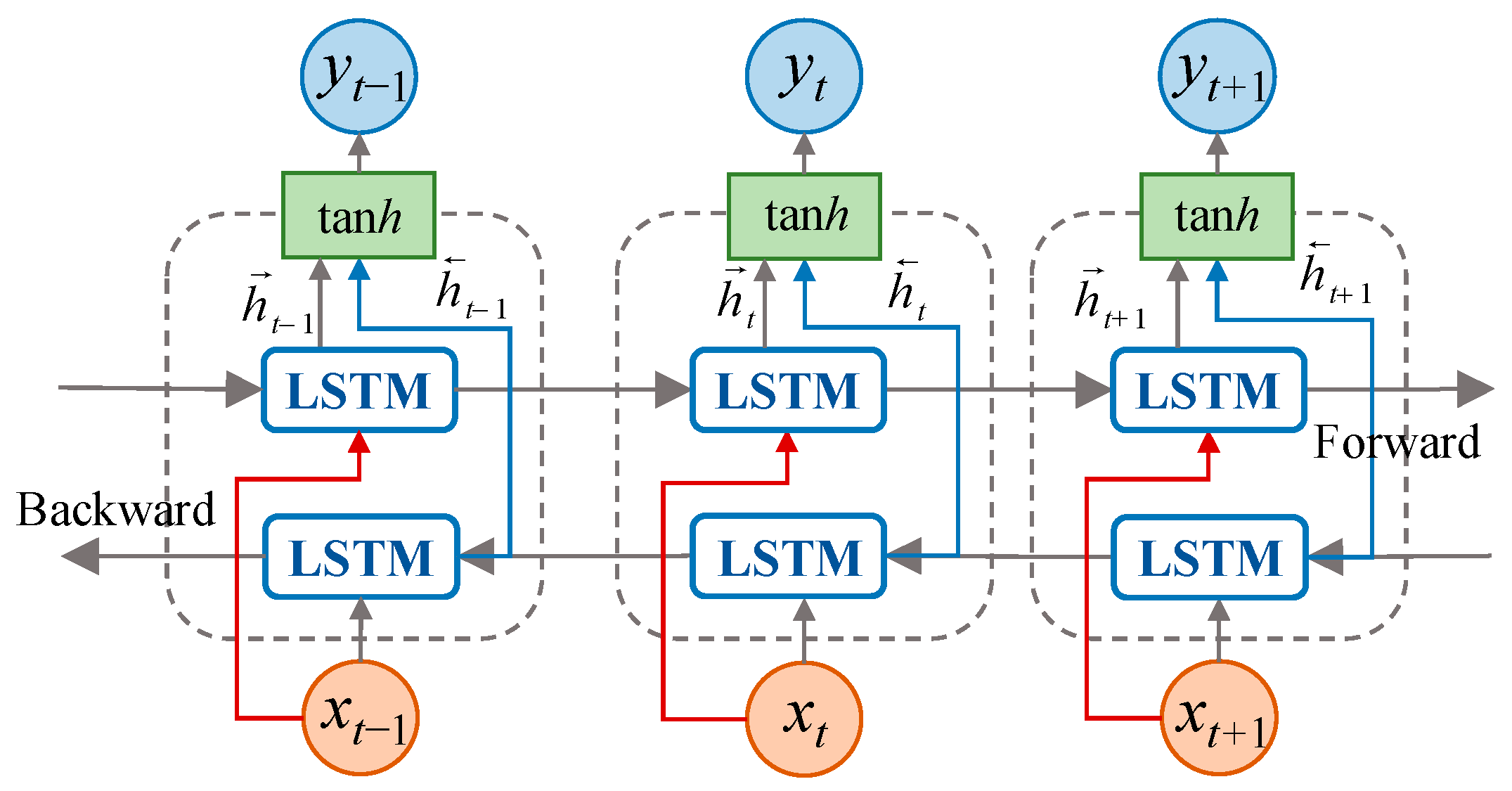
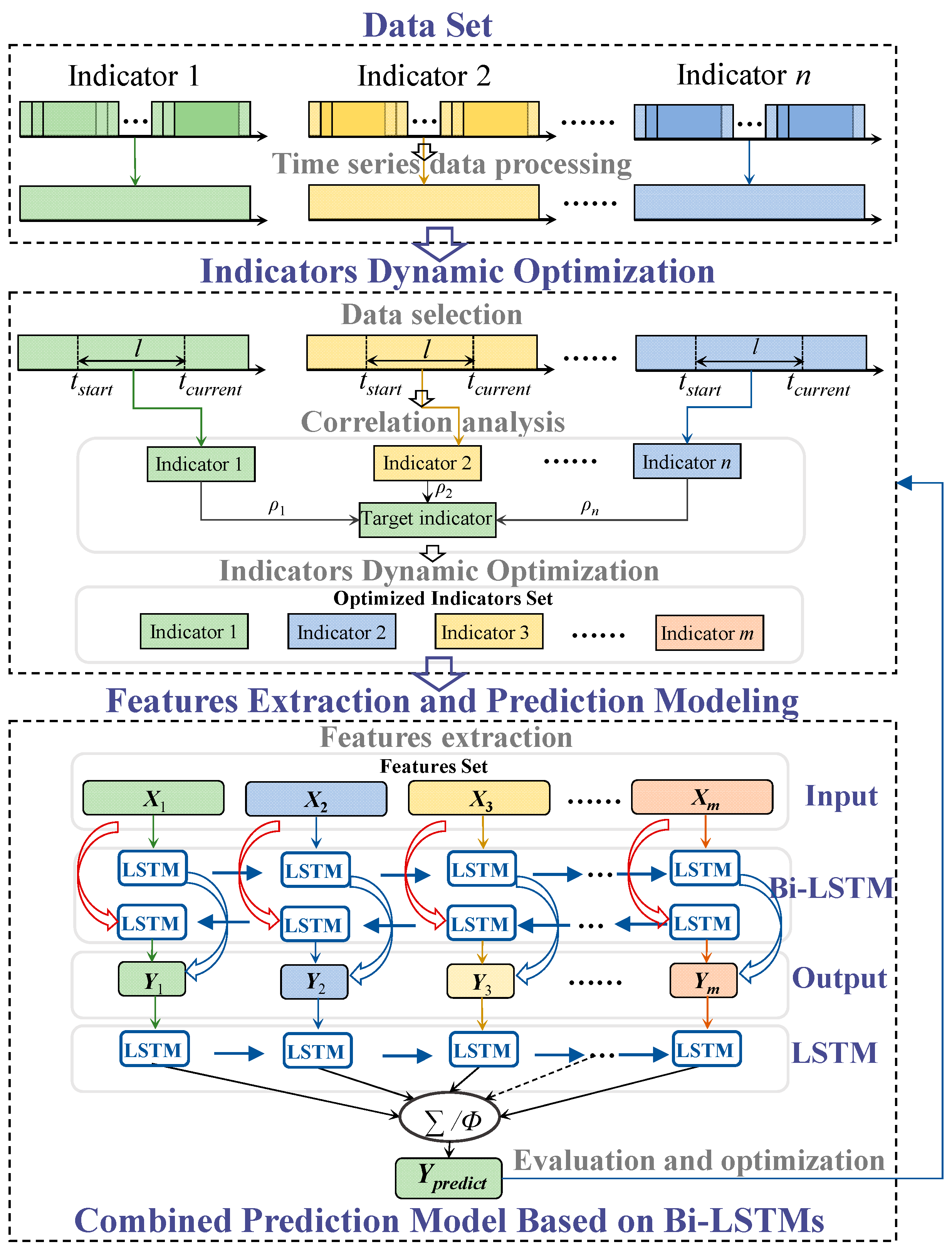

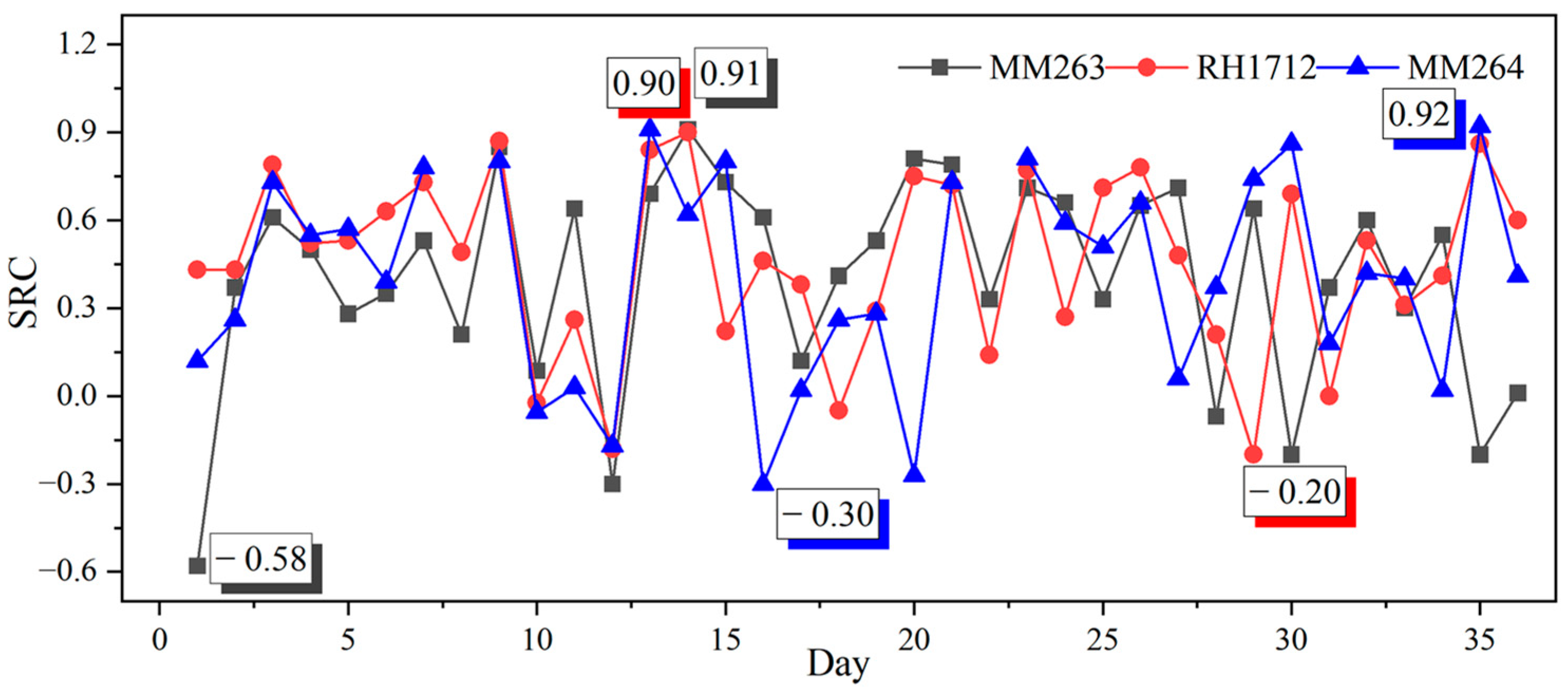
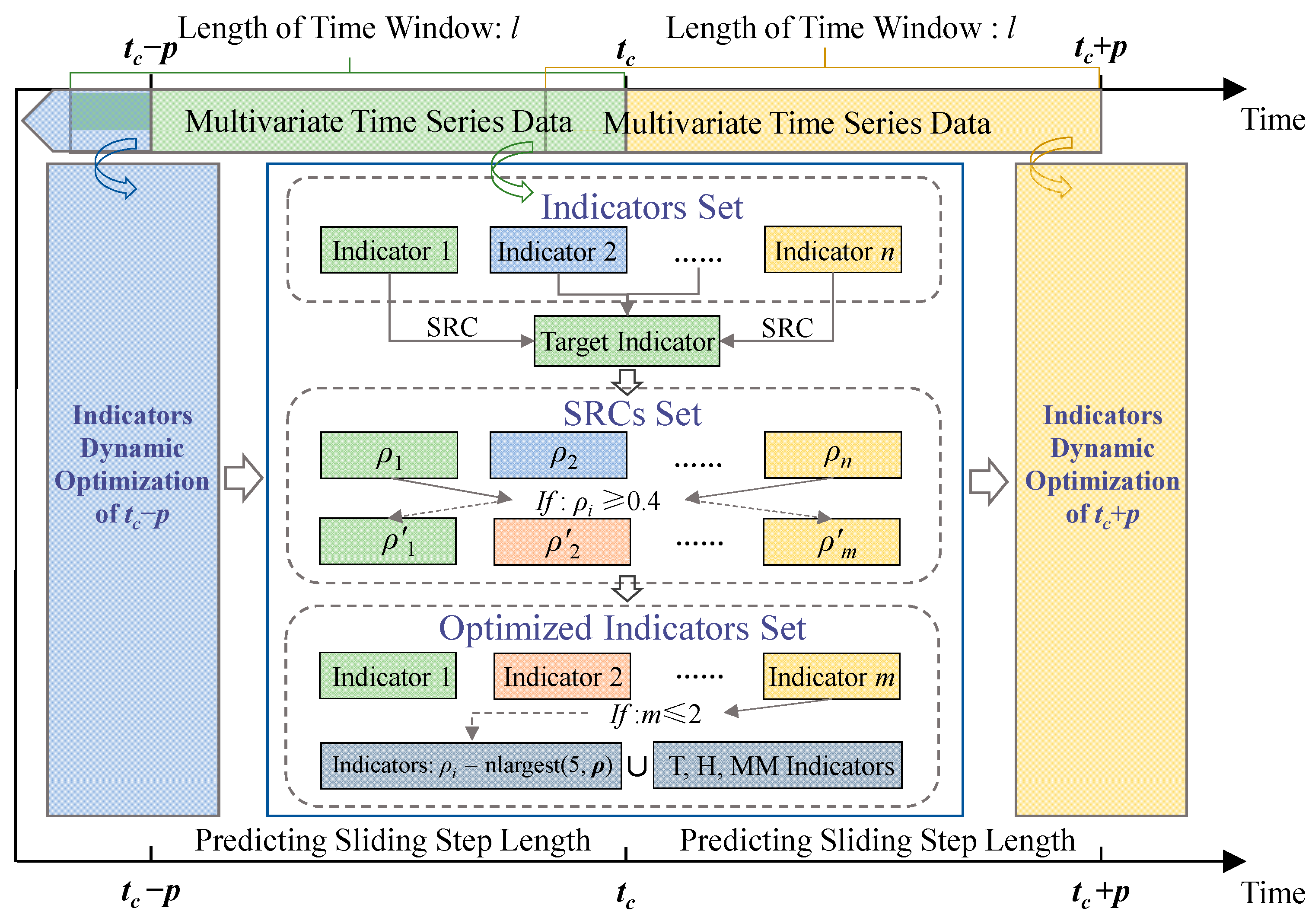


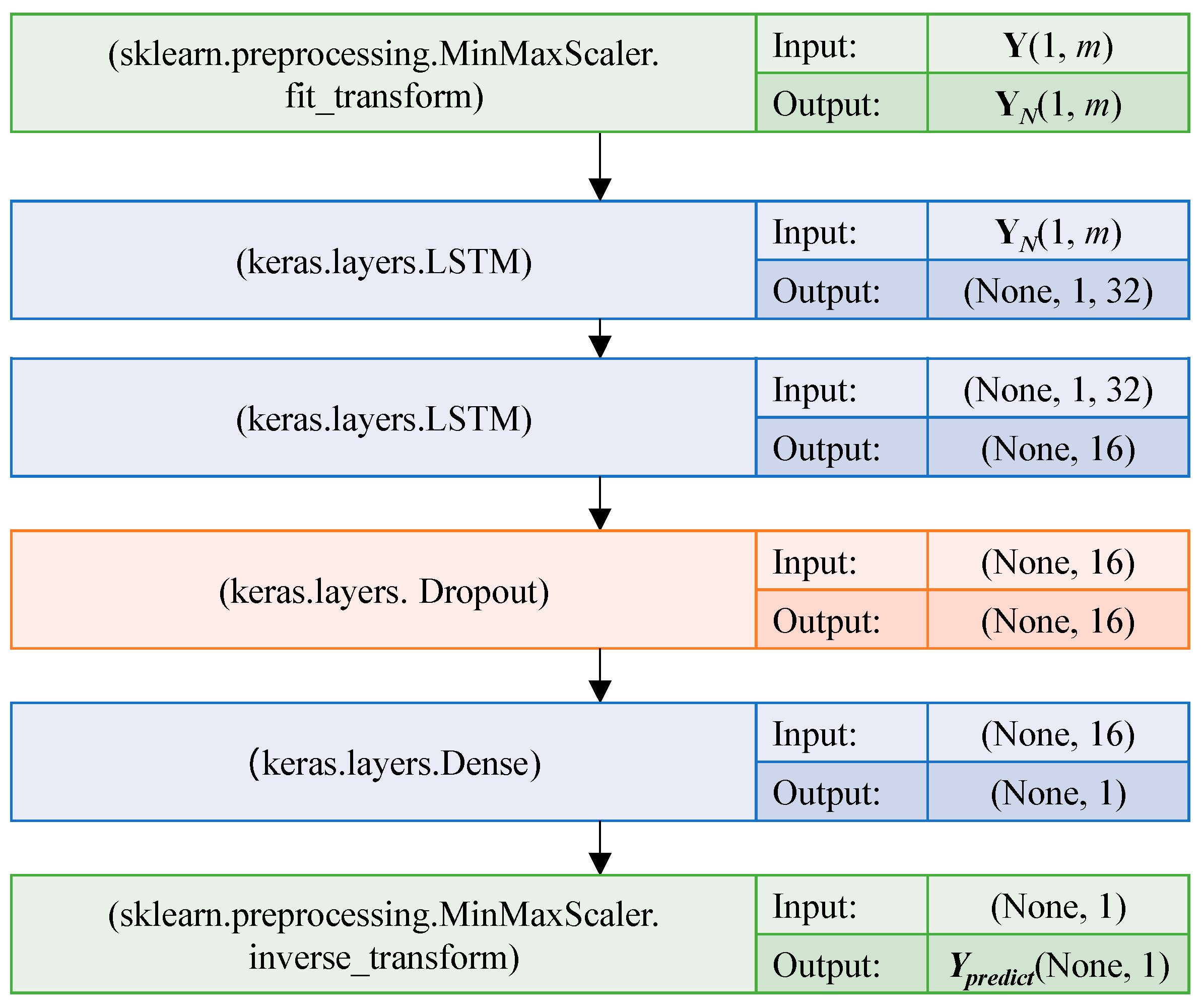


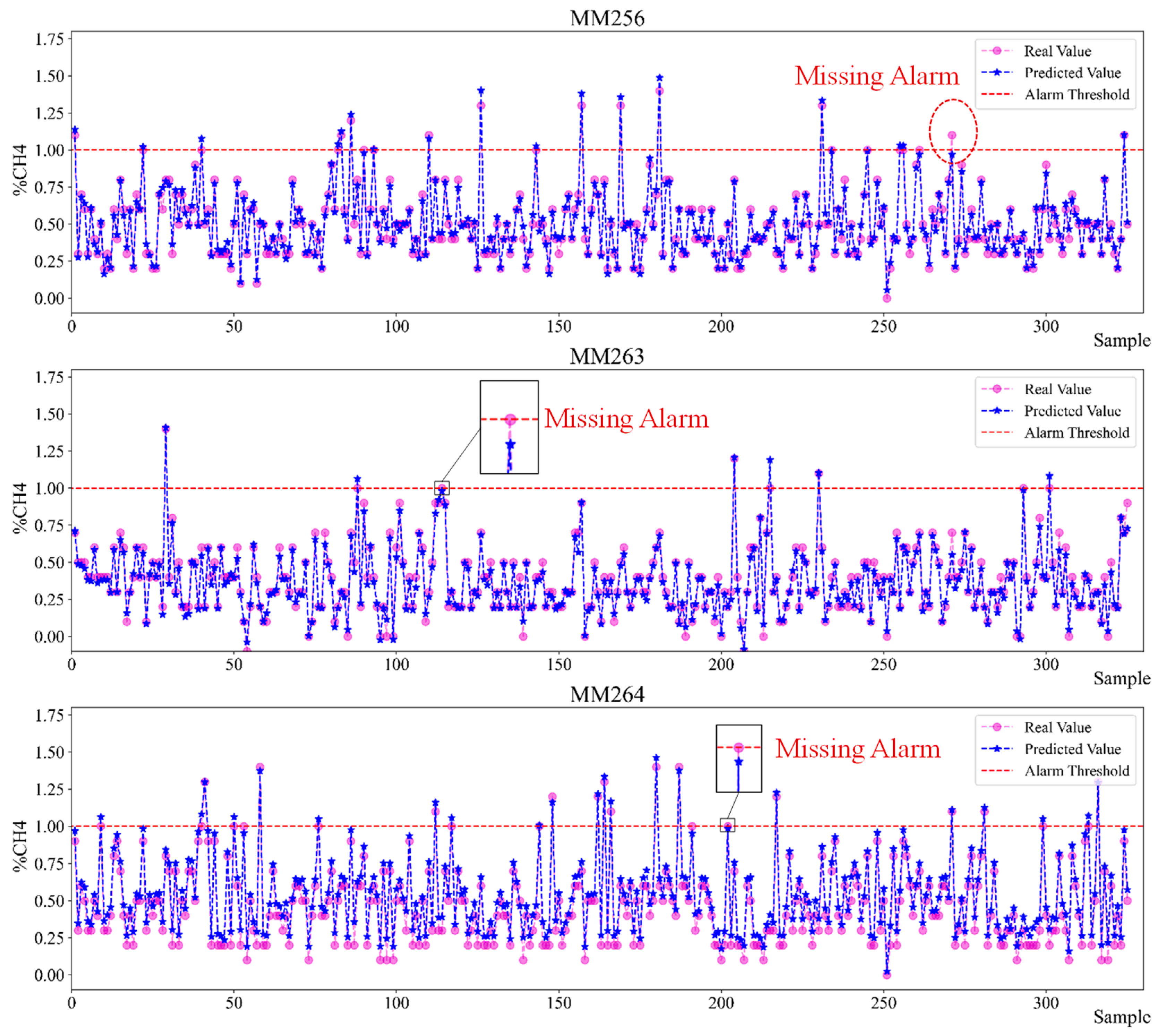
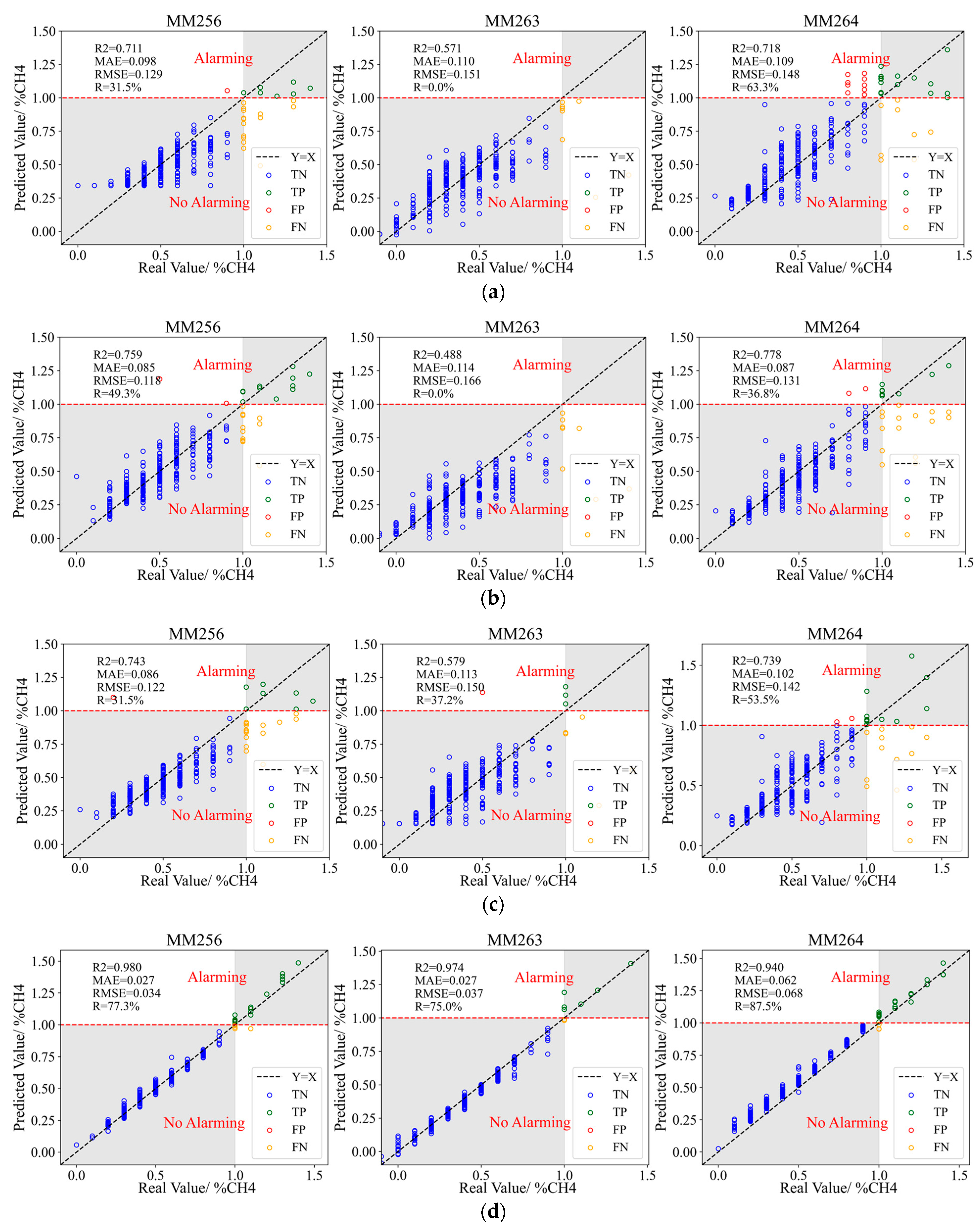
| Day | The Top 1 Indicator and SRC | The Top 2 Indicator and SRC | The Top 3 Indicator and SRC | |||
|---|---|---|---|---|---|---|
| day 22 | MM263 | 0.79 | TP1711 | 0.76 | TC862 | 0.73 |
| day 23 | MM262 | 0.51 | MM252 | 0.45 | MM211 | 0.34 |
| day 24 | MM264 | 0.81 | RH1712 | 0.77 | MM263 | 0.71 |
| day 25 | MM263 | 0.66 | MM264 | 0.59 | MM211 | 0.58 |
| day 26 | RH1712 | 0.71 | MM264 | 0.51 | AMP1 | 0.5 |
| day 27 | RH1712 | 0.78 | MM264 | 0.66 | MM263 | 0.65 |
| day 28 | MM263 | 0.71 | AMP1 | 0.49 | RH1712 | 0.48 |
| Indicator(s) | Sensor | R2 | MAE | RMSE | R2′ | MAE′ | RMSE′ |
|---|---|---|---|---|---|---|---|
| Single Indicator | MM256 | 0.711 | 0.098 | 0.129 | 0.667 | 0.156 | 0.143 |
| MM263 | 0.571 | 0.110 | 0.151 | ||||
| MM264 | 0.718 | 0.109 | 0.148 | ||||
| All Indicators | MM256 | 0.759 | 0.085 | 0.118 | 0.675 | 0.095 | 0.138 |
| MM263 | 0.488 | 0.114 | 0.166 | ||||
| MM264 | 0.778 | 0.087 | 0.131 | ||||
| Specified Indicators | MM256 | 0.743 | 0.086 | 0.122 | 0.687 | 0.100 | 0.138 |
| MM263 | 0.579 | 0.113 | 0.150 | ||||
| MM264 | 0.739 | 0.102 | 0.142 | ||||
| Optimized Indicators | MM256 | 0.980 | 0.027 | 0.034 | 0.965 | 0.039 | 0.046 |
| MM263 | 0.974 | 0.027 | 0.037 | ||||
| MM264 | 0.940 | 0.062 | 0.068 |
| Indicator(s) | Sensor | TP | FN | TN | FP | FAR | MAR | R | FAR′ | MAR′ | R′ |
|---|---|---|---|---|---|---|---|---|---|---|---|
| Single Indicator | MM256 | 7 | 15 | 302 | 1 | 0.3% | 68.2% | 31.5% | 1.2% | 67.2% | 31.6% |
| MM263 | 0 | 8 | 317 | 0 | 0.0% | 100.0% | 0.0% | ||||
| MM264 | 16 | 8 | 291 | 10 | 3.3% | 33.3% | 63.3% | ||||
| All Indicators | MM256 | 11 | 11 | 301 | 2 | 0.7% | 50.0% | 49.0% | 0.4% | 70.8% | 28.7% |
| MM263 | 0 | 8 | 317 | 0 | 0.0% | 100.0% | 0.0% | ||||
| MM264 | 9 | 15 | 299 | 2 | 0.7% | 62.5% | 36.8% | ||||
| Specified Indicators | MM256 | 7 | 15 | 302 | 1 | 0.3% | 68.2% | 31.5% | 0.4% | 58.8% | 40.7% |
| MM263 | 3 | 5 | 316 | 1 | 0.3% | 62.5% | 37.2% | ||||
| MM264 | 13 | 11 | 299 | 2 | 0.7% | 45.8% | 53.5% | ||||
| Optimized Indicators | MM256 | 17 | 5 | 303 | 0 | 0.0% | 22.7% | 77.3% | 0.0% | 20.1% | 79.9% |
| MM263 | 6 | 2 | 317 | 0 | 0.0% | 25.0% | 75.0% | ||||
| MM264 | 21 | 3 | 301 | 0 | 0.0% | 12.5% | 87.5% |
Disclaimer/Publisher’s Note: The statements, opinions and data contained in all publications are solely those of the individual author(s) and contributor(s) and not of MDPI and/or the editor(s). MDPI and/or the editor(s) disclaim responsibility for any injury to people or property resulting from any ideas, methods, instructions or products referred to in the content. |
© 2023 by the authors. Licensee MDPI, Basel, Switzerland. This article is an open access article distributed under the terms and conditions of the Creative Commons Attribution (CC BY) license (https://creativecommons.org/licenses/by/4.0/).
Share and Cite
Peng, Y.; Song, D.; Qiu, L.; Wang, H.; He, X.; Liu, Q. Combined Prediction Model of Gas Concentration Based on Indicators Dynamic Optimization and Bi-LSTMs. Sensors 2023, 23, 2883. https://doi.org/10.3390/s23062883
Peng Y, Song D, Qiu L, Wang H, He X, Liu Q. Combined Prediction Model of Gas Concentration Based on Indicators Dynamic Optimization and Bi-LSTMs. Sensors. 2023; 23(6):2883. https://doi.org/10.3390/s23062883
Chicago/Turabian StylePeng, Yujie, Dazhao Song, Liming Qiu, Honglei Wang, Xueqiu He, and Qiang Liu. 2023. "Combined Prediction Model of Gas Concentration Based on Indicators Dynamic Optimization and Bi-LSTMs" Sensors 23, no. 6: 2883. https://doi.org/10.3390/s23062883
APA StylePeng, Y., Song, D., Qiu, L., Wang, H., He, X., & Liu, Q. (2023). Combined Prediction Model of Gas Concentration Based on Indicators Dynamic Optimization and Bi-LSTMs. Sensors, 23(6), 2883. https://doi.org/10.3390/s23062883








